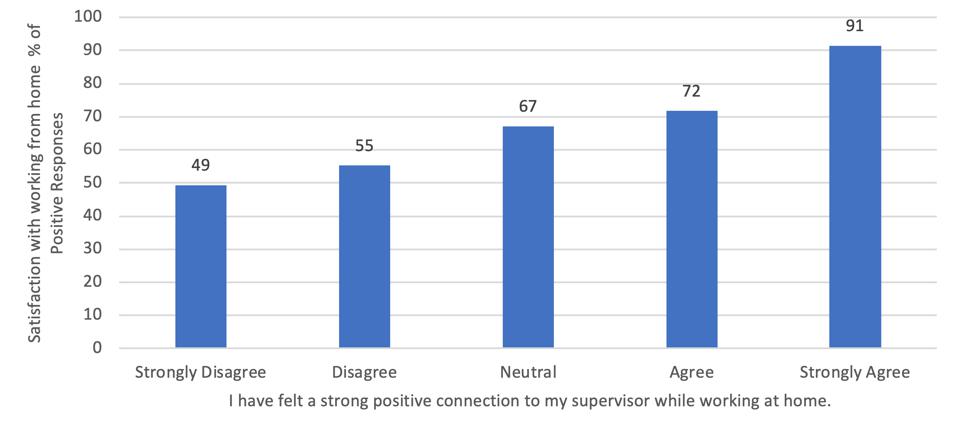Survey shows how employees really feel about working from home

Discovering the Leader’s PPE

You have to be fast to be seen as a great leader


I have been gathering data about the level of satisfaction people have while working at home. So far I have gathered reactions from a diverse sample of 312 people. In the data set, I have 32% male and 68% female respondents. People come from various functions, and 15% are top management, 22% senior leaders, 19% middle managers, 10% supervisors, and 32% individual contributors. The data comes from across the globe, but the majority is from the U.S. Here are a few observations from my initial data.
1. The majority of respondents like working from home. When asked if they enjoyed working from home, 82% agreed or strongly agreed. 60% said they feel less stressed working from home, and 66% thought that they were more productive working from home. The initial research on working from home done prior to the Pandemic found that productivity increased. But there have been concerns from some that productivity in the Pandemic may decline. Nicholas Bloom, a Stanford Economist, said in an interview, “The global work-from-home movement intended to maintain output and efficiency during the COVID-19 Pandemic could generate a worldwide productivity slump and threaten economic growth for many years.”
However, it is clear that many organizations are not in a big hurry to return to the office. A variety of different companies have announced that they will be working remotely well into 2021. If there is a productivity slump, many organizations have not recognized the decrease.
2. The engagement of those working from home has not significantly declined. In pre-pandemic data, we have collected from 537,591 employees on a five-item employee engagement index, 79% of the responses to the index were positive. From the 312 samples of respondents working from home in the Pandemic, the results were 77% positive. That is not a significant difference. Given all the stress and worries with the Pandemic, a slight reduction in engagement is expected.
3. The most significant factor that impacts both satisfaction in working from home and engagement, is the extent to which people feel they have a secure positive connection with their supervisor. The graph below shows the results of the 312 people in our study. Each person was asked if they “felt a strong positive connection to their supervisor while working at home.” Note that those who strongly disagreed—(e.g., their supervisor was not supportive—responded positively to only 42% of the engagement items. Those who strongly agreed responded positively to 90% of the items.
We also measured the impact of a supportive supervisor with satisfaction from working at home. The satisfaction in working from home is composed of the following three items.

– I enjoy working from home.
– I feel less stressed and anxious while working from home.
– I feel I am more productive working from home.
Note the impact of having a supportive supervisor, with 91% of the responses being positive when a person marked “strongly agree.”

4. Working from home makes males feel more overwhelmed than females. We asked respondents to respond to the item, “I feel overwhelmed with too many priorities from both work and family.” 60% of males agreed or strongly agreed with that statement. Only 47% of females agreed or strongly agreed. For comparison, we examined a similar item assessing how overwhelmed respondents felt on data gathered from over 2,700 respondents (968 males and 1,744 females) in a pre-pandemic period. On that assessment, only 27% of males agreed or strongly agreed, and 33% of females agreed or strongly agreed that they were overwhelmed. That data indicated that before the Pandemic, women felt more overwhelmed. It has been widely known that women typically do most of the household tasks. In a 2019 Gallup assessment, Megan Brenan indicated only 9% of males were more likely to clean the house, 17% more likely to prepare meals, 7% more likely to care for children. Both males and females feel more overwhelmed in the Pandemic, but males are feeling it much more. I am personally skeptical that males are doing more household work than females, but rather they are doing more than they typically do.
After looking over this data, I am optimistic that most people are satisfied while working from home. The key to high satisfaction is closely tied to having a very supportive manager. The self-reports on productivity are positive, but some people may be more optimistic than real productivity measures reveal. In my case, the Pandemic has canceled all my travel and shifted much of my work from classrooms to Zoom, and Microsoft Team calls. A typical trip would cost me a day of travel before an engagement and another day of travel after the engagement. Having only a Zoom call on the engagement day has doubled my productivity, but video calls are not always as high impact as an in-person meeting.
Source : zengerfolkman.com



